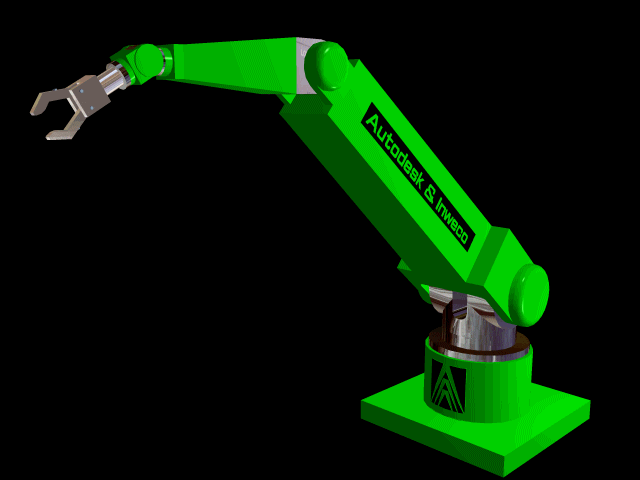|
The robot arm comes
in all shapes and sizes and is the single most important part in
robotic architecture. The arm is the part of the robot that positions
the End Effector and Sensors to do their pre-programmed business. Many
(but not all) resemble human arms, and have shoulders, elbows, wrists,
even fingers. This gives the robot a lot of ways to position itself in
its environment.
 Many robots resemble human arms, and have shoulders, elbows,
wrists, even fingers. This gives a robot lots of options for moving,
and helps it do things in place of a human arm. In order to reach any
possible point in space within its work envelope, a robot uses a total
of 7 degrees of freedom. Each direction a joint can go gives an arm 1
degree. So, a simple robot arm with 3 degrees of freedom could move in
3 ways: up and down, left and right, forward and backward. Many robots
of today are designed to move with these 7 degrees of freedom. Many robots resemble human arms, and have shoulders, elbows,
wrists, even fingers. This gives a robot lots of options for moving,
and helps it do things in place of a human arm. In order to reach any
possible point in space within its work envelope, a robot uses a total
of 7 degrees of freedom. Each direction a joint can go gives an arm 1
degree. So, a simple robot arm with 3 degrees of freedom could move in
3 ways: up and down, left and right, forward and backward. Many robots
of today are designed to move with these 7 degrees of freedom.
The human arm is an amazing design. It allows us to place our
all-purpose end effector, the hand, where it is needed. Jointed arm
robots mimic the ability of human arms to be flexible, precise, and
ready for a wide variety of tasks. The jointed-arm robot has six
degrees of freedom, which enable it to perform jobs that require
versatility and dexterity. The design of a jointed-arm robot is
similar to a human arm, but not exactly the same.
The robotic arm
is very similar to the human arm in that it has the capability of
having 7 and not 6 degrees of movement, as previously thought. Out of
the 7 degrees of movement, your shoulder has 3 of the arm�s 7 degrees
of freedom. The easiest way to explain the movement of the robotic arm
is to use your own arm as an example. Hold out your arm and follow
along . . .
To find your
arm's first degree of freedom:
Point your entire arm straight out in front of you. Move your shoulder
up and down. The up and down movement of the shoulder is called the
shoulder pitch.
To find your
arm's second degree of freedom:
Point your entire arm straight out in front of you. Move your entire
arm from side to side. This side to side movement is called the arm
yaw.
To find your
arm's third degree of freedom:
Point your entire arm straight out in front of you. Now, roll your
entire arm from the shoulder, as if you were screwing in a light bulb.
This rotating movement is called a shoulder roll.
To find your
arm's fourth degree of freedom:
Point your entire arm straight out in front of you. Hold your arm
still, then bend only your elbow. Your elbow can move up and down.
This up and down movement of the shoulder is called the shoulder
pitch.
To find your
arm's fifth degree of freedom:
Point your entire arm straight out in front of you. Without moving
your shoulder or elbow, flex your wrist up and down. This up and down
movement of the wrist is called the wrist pitch.
To find your
arm's sixth degree of freedom:
Point your entire arm straight out in front of you. Without moving
your shoulder or elbow, flex your wrist from side to side. The side to
side movement is called the wrist yaw.
To find your
arm's seventh degree of freedom:
Point your entire arm straight out in front of you. Without moving
your shoulder or elbow, rotate your wrist, as if you were turning a
doorknob. The rotation of the wrist is called the wrist roll. |